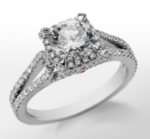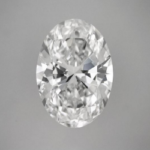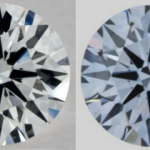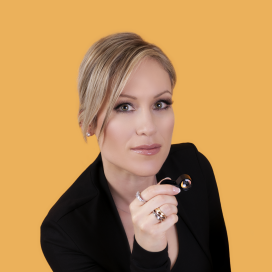Diamonds 101
“A Proper Introduction Into The World Of Diamonds”
Dear Diamond Visitor:
Buying diamonds isn’t just about understanding cut, color, clarity and carat weight independently. The art of diamond buying is being able to evaluate a diamond based on a comprehensive view of all it’s varying characteristics. Being able to search online through the thousands of available diamonds takes some experience, but you don’t have to be a graduate gemologist or have worked in the diamond industry to be able to pick out a beautifully cut diamond. All you really need to know is what to look for. Do you know what to look for?
First of all, of primary importance and above ALL ELSE, it is imperative that you look at diamonds that have a valid 3rd party grading report. In the United States the two most popular are GIA and AGSL. In Europe and elsewhere you’ll find EGL, HRD, and IGI. All laboratories are different and have different standards by which they grade cut, color, clarity, and carat weight. A diamond grading report should serve as a guide only, not the ultimate seal of approval. You’ll need to do a bit more investigative work if you want to find a great quality cut diamond at a fair price.
Secondly, diamond cut is the most important aspect of a non-fancy colored diamond. This is a fact. If you hear different then you should have your alarm bells ringing. How a diamond is cut affects its:
- Brightness – how bright or white a diamond is as determined by the reflections of white light reflected back to the observer
- Fire – the rainbow colors observed in a diamond as a result of dispersion
- Leakage – light that escapes from the pavilion of a diamond
- Contrast – dark/light contrast in diamond
- Scintillation – tiny flashes of light that are noticeable when a diamond is moved; a diamond’s sparkle
- Spread – apparent size of a diamond; a diamond of the same weight but larger diameter is said to ‘spread’ more
Given this information there really is no point in buying a diamond that has no 3rd party grading report or that is of an inferior or poor cut quality. The rest (color, clarity, diamond shape, and carat weight) is up to you. This site is meant to give you the information that you need in order to determine what kind of diamond makes the most sense for your taste, budget and lifestyle.
So, with that being said there are questions that you need to ask yourself when considering any loose diamond purchase. Many jewelers and vendors cannot even answer these questions. Take a look at the following and gauge for yourself how confident you feel about making a diamond purchase:
Diamond FAQ’s
- Which diamond grading laboratories are the most reliable in their grading and offer the highest grading standards? Why is this important?
- Do you know what inclusions are acceptable while others might pose a durability or vulnerability issue?
- Does the location of the inclusion(s) matters?
- Which inclusions can make the diamond vulnerable to cleaving/chipping?
- Do you know the difference between GIA’s triple “excellent” (excellent cut, polish and symmetry) cut grade and AGSL’s triple “0” (ideal light performance, ideal polish, and ideal symmentry) cut grade?
- Did you know that two diamonds with the exact same GIA grading report can look completely different? In some cases the value of these stones can differ as much as several thousand dollars. Do you know why?
- Why can two diamonds with the same table and depth percentage look completely different?
- What is a laser drilled diamond vs. a fracture filled diamond and how can you tell the difference?
- How does diamond fluorescence affects its beauty? Is it worth it to buy a diamond with strong blue fluorescence but costs less?
- How is it possible for an SI2 clarity diamond to look “cleaner” than an SI1?
- If a diamond is described as “ideal” does this mean you can trust it will be a perfectly proportioned diamond with maximum brilliance?
- Which diamond shape is the most brilliant and shows off the most light reflection?
- Why are Hearts and Arrows diamonds sold at a premium? How do you know if a diamond is a “true” H&A diamond?
- Why are the majority of diamonds sold on the market today intentionally cut too “deep/steep”? Who does this benefit?
- How important is optical symmetry? Where can you find this information?
- Why are some GIA “very good” cut grades sometimes MORE brilliant than some “excellent” cut grades?
- How important is polish/symmetry in a diamond when compared to its proportions?
- Why is shopping for diamonds online actually safer than buying in a brick and mortar store?
- Who can you trust and where should you buy your diamond? Does it really matter?
If you are a discerning diamond buyer, then these questions are relevant to your search for a loose diamond. Most jewelers and online diamond dealers don’t want you to concern yourself with these questions because it makes their job easier to possibly sell you an inferior stone. However, if you want to ensure you get a superior quality diamond, you really need to familiarize yourself with these simple facts. It isn’t just looking at magnified diamond pictures online. There is a certain finesse to diamond buying that really does require patience as well as knowledge.
All of these questions have been answered here at ODBA plus plenty more tips and tricks to saving thousands on your diamond purchase. Stick with me on this journey and we’ll find a perfect diamond for you together…
Hey.You Want Ideal Cut Diamonds?
You've got it.
Join ODBA's Diamond Deal Friday and get handpicked diamonds every week from me to you.
No consultation required. Subscribe now!
ODBA Recommends
You May Also Like









